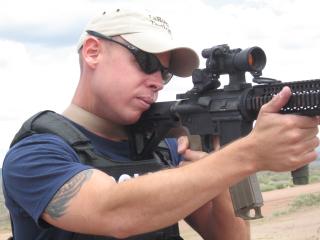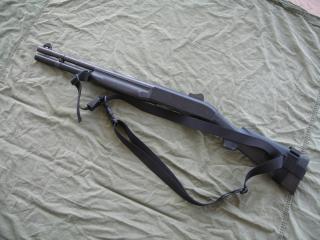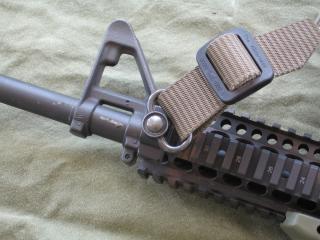
 A regular three-point sling can present a choking hazard when transitioning to
the weak-side shoulder.
The main problems with three-point slings are that the straps are
often restrictive in non-standard shooting positions and they can get
in the way when operating AR-15 weapons systems or shotguns. With a
basic three-point sling, transitioning to the weak shoulder to shoot
from the other side of cover can range from mild strangulation to
impossible. Some three-point slings such as the SOT and CST from
Specter Gear and the Blackhawk Industries Swift Sling incorporate a
release buckle which allows the "body" loop to slide back. This
allows weak-shoulder transitions, but it is still somewhat awkward.
Another consideration with the three-point sling is that the multiple straps can
get hung up on SWAT gear or load-bearing harnesses. In addition, for
left-handed shooters, the strap closest to the gun can interfere with an AR-15's
ejection port.

 A Benelli M1S90 Tactical sports a Specter Gear Cross-Shoulder Transision (CST)
three-point sling.
I checked out six three-point slings for this review. The first is Giles
Tactical Sling made by The Wilderness. It is as simple as a three-point can
get, but it gets the job done nicely. For a shooter without special
applications, the Giles Tactical Sling will fit the bill at a good price.
Specter Gear, once called CQB Solutions, has made some of the most dramatic
improvements in three-point sling design. The first basic improvement is an
emergency release buckle (ERB) on their CQB Sling, which untangles the shooter
from the main sling loop. The next improvement is in the Cross-Shoulder
Transition (CST) Sling. The CST has a slider which allows the shooter to adjust
the body loop position on the fly, which allows him to shoot from his weak-side

 Two- and three-point slings may be connected to the front of the rifle either
with a simple loop, or a quick-detach (QD) swivel. Here the Knights Armament QD
sling swivel is used.
shoulder without choking himself. The last offering from Specter Gear I looked
at was the Special Operations Patrol (SOP) Sling. This design is based on the
CST, but adds offset one-inch loops at both ends to connect to the weapon for
increased freedom of movement and changes the main loop width to one and a half
inches to better distribute the weight of the weapon. All the slings from
Specter Gear are available with an ERB.
The SPEC-OPS Brand MAMBA sling is very similar to the Specter Gear CQB Sling,
but distinguishes itself with a bungee portion of the body loop at the rear of
the sling. The addition of the bungee material is unconventional, but sometimes
just a little more mobility is required when trying to clear gear or transition,
and the bungee can provide it. Finally, the Blackhawk Industries Swift Sling
follows the same basic three-point pattern, but has a buckle for cross-shoulder
transitions. Once this buckle is released, it requires two hands to reset and
is somewhat awkward.
Most of these slings can be fitted to carbine, rifle, shotgun, or SMG
with adapters available from the manufacturer. Single-point sling
designs generally need a receiver loop. Two- and three-point slings
can be attached to a the M16A2's fore-end and stock, or they can be
connected using the quick-detach sling swivels pictured in this
article.
|